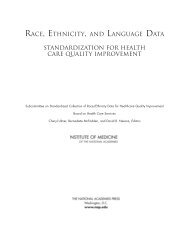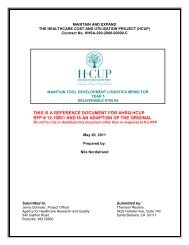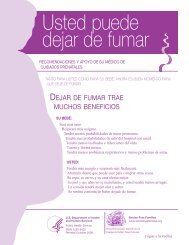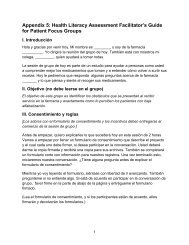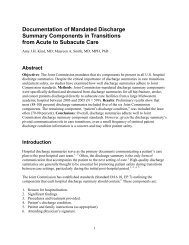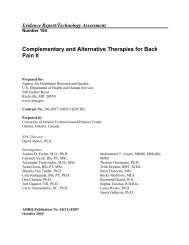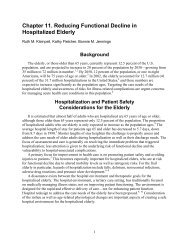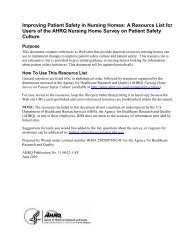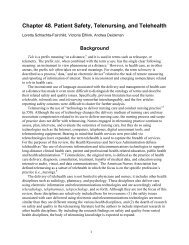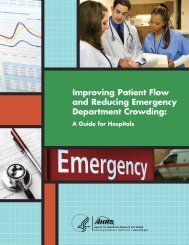Chapter 46. Magnet Environments for Professional Nursing Practice
Chapter 46. Magnet Environments for Professional Nursing Practice
Chapter 46. Magnet Environments for Professional Nursing Practice
You also want an ePaper? Increase the reach of your titles
YUMPU automatically turns print PDFs into web optimized ePapers that Google loves.
Patient Safety and Quality: An Evidence-Based Handbook <strong>for</strong> Nurses<br />
<strong>Magnet</strong> application process. Whereas previous application manuals had itemized evidence<br />
requirements according to ANA’s Scope and Standards <strong>for</strong> Nurse Administrators, 15 the new<br />
manual version 11 reorganized the criteria into the framework of the <strong>for</strong>ces of magnetism. This<br />
transition should help to clarify the correspondence between the elements ANCC’s <strong>Magnet</strong><br />
program evaluates in its appraisal process and the magnet characteristics that nursing and health<br />
services researchers study.<br />
Reviewing the Evidence<br />
Research studies were retrieved <strong>for</strong> this review by searching PubMed ® and CINAHL ® <strong>for</strong><br />
articles referencing magnet or magnetism in the title or abstract. Two inclusion criteria were<br />
used. (More details can be found below, in “Search Strategy.”) The articles had to (a) report<br />
findings from analyses of primary or secondary data, and (b) investigate relationships between<br />
magnet variables and nurse or patient outcomes. Nurse outcomes of interest were job<br />
satisfaction, burnout, and intention to leave 16, 17 or similar variables such as mental health. Nurse<br />
perceptions of patient care quality has been a frequently used measure in the magnet-related<br />
survey research, and one study used nurse perceptions of safety climate as the dependent<br />
variable. But studies that included patient outcome variables measured from other sources were<br />
seldom found, although patient mortality and patient satisfaction are represented in the evidence<br />
tables.<br />
Limitations of the Research<br />
Overwhelmingly, the magnet research has been dominated by cross-sectional survey studies<br />
with convenience samples of organizations and staff nurse respondents. The basic approaches<br />
used to capture magnet environments in the research have been to include organizations from the<br />
1983 magnet study or with ANCC <strong>Magnet</strong> recognition in the hospital sample or to administer<br />
survey scales believed to measure magnet characteristics, traits, or factors. Usually, but not<br />
always, these approaches have been used in combination. Analyses have typically been limited<br />
to simple comparisons of survey items or subscale results between two groups.<br />
With few exceptions, the majority of this research has suffered from two major limitations:<br />
biased sampling at both the organizational and respondent level; and a scarcity of<br />
comprehensive, valid, and reliable measures <strong>for</strong> assessing the level of magnet characteristics<br />
present in any setting. Unless magnet characteristics are measured adequately across the<br />
organizations participating in a study, the degree to which their presence differs between the<br />
comparison groups cannot be assessed. Because the organizations that have attained ANCC<br />
<strong>Magnet</strong> recognition constitute a voluntary sample, it is possible that high levels of some or many<br />
magnet characteristics may also exist in other organizations that have not chosen to apply <strong>for</strong> the<br />
recognition.<br />
Overwhelmingly, the survey scales most frequently used to measure magnet characteristics<br />
have all derived from the <strong>Nursing</strong> Work Index (NWI). Because these scales have dominated the<br />
magnet research, it is important to understand how they are constituted and how they have<br />
evolved over time. The first version of the NWI was designed to inclusively and<br />
comprehensively reflect the findings of the 1983 magnet research study. 18 It was intended to<br />
measure four variables: work values related to staff nurse job satisfaction, work values related to<br />
perceived productivity, staff nurse job satisfaction, and perceived productivity (the perception of<br />
4



